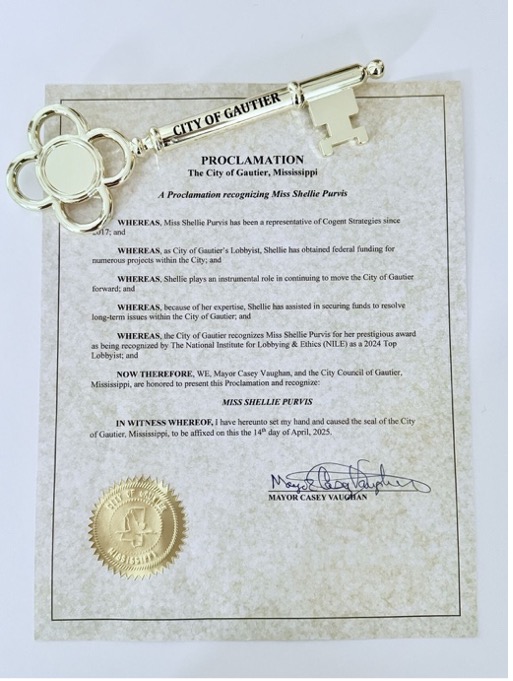Are your funding applications disappearing into federal bureaucracy? Ever wonder how some neighboring cities and counties are quietly securing millions in infrastructure investments?
Securing federal funding assistance isn’t a lottery — it’s a chess game where foresight beats hope every time. Here is the key to “a key to the city.”


Cogent Strategies managing director Shellie Purvis receives the key to city hall from our client, the City of Gautier, Mississippi.
The Current Infrastructure Reality
Municipal leaders across America face an infrastructure crisis that demands immediate action. The American Society of Civil Engineers estimates a $2.6 trillion infrastructure investment gap over the next decade, while water infrastructure alone requires $625 billion over the next 20 years. Surface transportation faces a $1.2 trillion funding shortfall over the same period, with bridges needing $373 billion over 10 years just to reach good repair. Congress is actively working on legislation that aligns with President Trump’s renewed focus on building infrastructure quickly, giving municipalities a prime opportunity to communicate their critical needs.
Yet the current political landscape presents both urgent challenges and strategic opportunities for savvy municipalities. Washington is seeing significant policy shifts with an emphasis on federal spending discipline. The existing Infrastructure Investment and Jobs Act funding will continue to flow through the pipeline, but it faces an uncertain future beyond 2026. Smart cities and counties understand today’s funding window may be tomorrow’s missed opportunity, making strategic positioning more important than ever as policymakers navigate evolving budget priorities.
The Strategic Execution Framework
Successful municipal advocacy requires more than submitting applications. It demands comprehensive strategy that anticipates challenges and maximizes opportunities:
- Congressional Champion Development: Build relationships with congressional members who can advocate during budget negotiations. This isn’t about political favors; it’s about educating policymakers on your community’s critical needs and economic impact.
- Multi-Stakeholder Coalition Building: Engage local business leaders, health care systems, educational institutions and public safety personnel who benefit from infrastructure improvements. Include state-level officials as key stakeholders and third-party validators. Their endorsement carries tremendous weight with federal decision-makers.
- Data-Driven Advocacy Materials: Develop compelling fact sheets that translate complex infrastructure needs into clear economic and community impacts. Federal officials respond to concrete numbers and measurable outcomes.
- Local Investment Commitment: Clearly communicate your municipality’s financial commitment and matching funds. Federal agencies prioritize projects where local governments have “skin in the game” because it demonstrates project viability and genuine community dedication to long-term success.
Timing Is Everything
The federal appropriations cycle follows a predictable timeline that municipalities must understand and leverage strategically:
- Presidential Budget Request: The administration’s budget request, typically due the first Monday in February, signals funding priorities and policy direction. New administrations often miss this deadline but eventually reveal their spending agenda through the budget proposal.
- Congressional Review Phase: What the president proposes and what Congress appropriates can differ significantly. Budget committee hearings and agency officials testifying before appropriations committees occur in the first quarter, setting the stage for funding decisions.
- Municipal Request Window: Members of Congress begin accepting constituent funding requests in February-March, with formal submissions to appropriations subcommittees due in March-April. Committee markups typically begin in late April.
- Strategic Preparation: Municipalities must work quickly to secure congressional champions, complete necessary paperwork and submit requests within tight deadlines. The federal funding process is tedious, tenuous and often delayed, making experienced guidance essential for successful navigation.
Strategic Imperatives for Municipal Leaders
- Map Your Federal Landscape: Identify all potential funding sources including the lesser-known programs, not just obvious municipal programs.
- Build Before You Need: Develop congressional and agency relationships during non-crisis periods when you can focus on education rather than emergency requests.
- Frame Strategically: Position infrastructure projects as economic development, addressing a health and safety need, or enabling community resilience that resonates with federal priorities.
- Prepare Comprehensively: Identify shovel-ready projects, develop professional advocacy materials, stakeholder coalitions and timing strategies before funding opportunities emerge.
- Think Multi-Year: Securing federal funding assistance rarely happens quickly, and successful cities understand sustained advocacy spanning multiple budget cycles is crucial.
The Bottom Line
Cities that master this approach don’t just secure funding; they transform their communities while building sustainable advocacy capacity for future challenges.
The question isn’t whether federal funding exists for your priorities. The question is whether you’re positioned strategically to capture it when opportunities arise.
Shellie Purvis
Managing Director
Named a “2024 Top Lobbyist,” Shellie Purvis excels in navigating complex federal funding landscapes, securing over $200 million for municipal and private sector clients across infrastructure, transportation, clean energy, and emergency management sectors. Her strategic approach to the budget and appropriations process transforms challenging objectives into funded initiatives. She has proven particularly effective in revitalizing small community infrastructure, advancing major metropolitan initiatives, and engineering congressional reporting requirements with critical federal policy implications. While others see roadblocks in Washington’s tight fiscal landscape, Shellie’s unique ability to discover alternative funding solutions has established her as a crucial partner for clients with complex federal objectives. Her command of both technical details and political dynamics enables her to consistently deliver results in even the most challenging budgetary environments.

